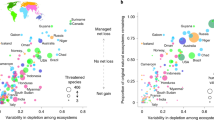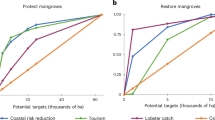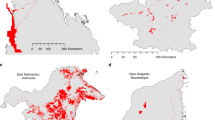Abstract
‘No net loss’ is a buzz phrase in environmental policy. Applied to a multitude of environmental targets such as biodiversity, wetlands and land productive capacity, no net loss (NNL) and related goals have been adopted by multiple countries and organizations, but these goals often lack clear reference scenarios: no net loss compared to what? Here, we examine policies with NNL and related goals, and identify three main forms of reference scenario. We categorize NNL policies as relating either to overarching policy goals, or to responses to specific impacts. We explore how to resolve conflicts between overarching and impact-specific NNL policies, and improve transparency about what NNL-type policies are actually designed to achieve.
This is a preview of subscription content, access via your institution
Access options
Access Nature and 54 other Nature Portfolio journals
Get Nature+, our best-value online-access subscription
$29.99 / 30 days
cancel any time
Subscribe to this journal
Receive 12 digital issues and online access to articles
$119.00 per year
only $9.92 per issue
Buy this article
- Purchase on Springer Link
- Instant access to full article PDF
Prices may be subject to local taxes which are calculated during checkout



Similar content being viewed by others
References
Rockstrom, J. et al. A safe operating space for humanity. Nature 461, 472–475 (2009).
Steffen, W. et al. Planetary boundaries: Guiding human development on a changing planet. Science 347, 1259855 (2015).
Robertson, M. M. No net loss: Wetland restoration and the incomplete capitalization of nature. Antipode 32, 463–493 (2000).
Salzman, J. & Ruhl, J. B. Gaming the past: The theory and practice of historic baselines in the administrative state. Vanderbilt Law Rev. 64, 1–57 (2010).
Cowie, A. L. et al. Land in balance: The scientific conceptual framework for implementing land degradation neutrality. Environ. Sci. Policy 79, 25–35 (2017).
WWF Living Forests Report Ch. 3 (WWF, 2011).
Maron, M. et al. Taming a wicked problem: Resolving controversies in biodiversity offsetting. BioScience 66, 489–498 (2016).
Rainey, H. J. et al. A review of corporate goals of no net loss and net positive impact on biodiversity. Oryx 49, 232–238 (2014).
Performance Standard 6: Biodiversity Conservation and Sustainable Management of Living Natural Resources (International Finance Corporation, 2012).
Villarroya, A., Persson, J. & Puig, J. Ecological compensation: From general guidance and expertise to specific proposals for road developments. Environ. Impact Assess. Rev. 45, 54–62 (2014).
Quétier, F., Regnery, B. & Levrel, H. No net loss of biodiversity or paper offsets? A critical review of the French no net loss policy. Environ. Sci. Policy 38, 120–131 (2014).
Virah-Sawmy, M., Ebeling, J. & Taplin, R. Mining and biodiversity offsets: A transparent and science-based approach to measure ‘no-net-loss’. J. Environ. Manage. 143, 61–70 (2014).
Maron, M., Bull, J. W., Evans, M. C. & Gordon, A. Locking in loss: Baselines of decline in Australian biodiversity offset policies. Biol. Conserv. 192, 504–512 (2015).
Gillenwater, M. What is Additionality? Part 1: A Long Standing Problem (Greenhouse Gas Management Institute, 2012).
Bull, J. W., Gordon, A., Law, E. A., Suttle, K. B. & Milner-Gulland, E. J. Importance of baseline specification in evaluating conservation interventions and achieving no net loss of biodiversity. Conserv. Biol. 28, 799–809 (2014).
Working Group on No Net Loss of Ecosystems and Their Services Scope and Objectives of the No Net Loss Initiative (European Commission, DG Environment, 2013).
Bill 5—2010: Zero Net Deforestation Act (Government of British Columbia, 2010).
Department of Sustainability, Environment, Water, Population and Communities Environment Protection and Biodiversity Conservation Act 1999: Environmental Offsets Policy (Australian Government, 2012).
Hoag, D. L. K. et al. Policy utopias for nutrient credit trading programs with nonpoint sources. J. Am. Water Resour. Assoc. 53, 514–520 (2017).
Stephenson, K. & Shabman, L. Nutrient assimilation services for water quality credit trading programs: A comparative analysis with nonpoint source credits. Coastal Manage 45, 24–43 (2017).
Brownlie, S. & Botha, M. Biodiversity offsets: adding to the conservation estate, or ‘no net loss’? Impact Assess. Proj. Appr. 27, 227–231 (2009).
Maseyk, F. et al. A disaggregated biodiversity offset accounting model to improve estimation of ecological equivalency and no net loss. Biol. Conserv. 204, 322–332 (2016).
Camaclang, A. E., Maron, M., Martin, T. G. & Possingham, H. P. Current practices in the identification of critical habitat for threatened species. Conserv. Biol. 29, 482–92 (2015).
IUCN Policy on Biodiversity Offsets (International Union for the Conservation of Nature, 2016).
Gordon, A., Bull, J. W., Wilcox, C. & Maron, M. Perverse incentives risk undermining biodiversity offset policies. J. Appl. Ecol. 52, 532–537 (2015).
Seyller, C. et al. The ‘virtual economy’ of REDD+ projects: Does private certification of REDD+ projects ensure their environmental integrity? Int. For. Rev. 18, 231–246 (2016).
Angelsen, A. in Moving Ahead with REDD: Issues, Options and Implications (ed. Angelsen, A.) Ch. 6 (CIFOR, Bogor, 2008).
Maron, M., Rhodes, J. R. & Gibbons, P. Calculating the benefit of conservation actions. Conserv. Lett. 6, 359–367 (2013).
Maseyk, F. J. F., Evans, M. C. & Maron, M. Guidance for Deriving ‘Risk Of Loss’ Estimates When Evaluating Biodiversity Offset Proposals Under the EPBC Act (National Environmental Science Programme, Threatened Species Recovery Hub, 2017).
Department of Environment, Water and Natural Resources Policy for a Significant Environmental Benefit Under the Native Vegetation Act 1991 and Native Vegetation Regulations 2017 2 (State of South Australia, 2017).
Pana, A. C. & Gheyssens, J. Baseline choice and performance implications for REDD. J. Environ. Econ. Policy 5, 79–124 (2016).
Bull, J. W., Suttle, K. B., Gordon, A., Singh, N. J. & Milner-Gulland, E. J. Biodiversity offsets in theory and practice. Oryx 47, 369–380 (2013).
Standard on Biodiversity Offsets (Business and Biodiversity Offsets Programme, 2012).
Fleischer, D. & Fox, J. in Conservation and Biodiversity Banking: A Guide to Setting Up and Running Biodiversity Credit Trading Systems (eds Carroll, N., Fox, J. & Bayon, R.) Ch. 4 (Earthscan, London, 2008).
Wilcove, D. S. & Lee, J. Using economic and regulatory incentives to restore endangered species: Lessons learned from three new programs. Conserv. Biol. 18, 639–645 (2004).
COAG Standing Council on Environment and Water Australia’s Native Vegetation Framework (Department of Sustainability, Environment, Water, Population and Communities, Australian Government, 2012).
Bull, J. W., Milner-Gulland, E. J., Suttle, K. B. & Singh, N. J. Comparing biodiversity offset calculation methods with a case study in Uzbekistan. Biol. Conserv. 178, 2–10 (2014).
Quétier, F., Van Teeffelen, A. J. A., Pilgrim, J. D., von Hase, A. & Kate, K. T. Biodiversity offsets are one solution to widespread poorly compensated biodiversity loss: a response to Curran. et al. Ecol. Appl. 25, 1739–1741 (2015).
Githiru, M. et al. Should biodiversity offsets help finance underfunded Protected Areas? Biol. Conserv. 191, 819–826 (2015).
Gibbons, P. et al. a loss-gain calculator for biodiversity offsets and the circumstances in which no net loss is feasible. Conserv. Lett 9, 252–259 (2016).
Sonter, L. J., Tomsett, N., Wu, D. & Maron, M. Biodiversity offsetting in dynamic landscapes: Influence of regulatory context and counterfactual assumptions on achievement of no net loss. Biol. Conserv. 206, 314–319 (2017).
Scaling-up Finance Mechanisms for Biodiversity (OECD Publishing, 2013).
Spash, C. L. Bulldozing biodiversity: The economics of offsets and trading-in Nature. Biol. Conserv. 192, 541–551 (2015).
Vaissière, A.-C., Levrel, H. & Scemama, P. Biodiversity offsetting: Clearing up misunderstandings between conservation and economics to take further action. Biol. Conserv. 206, 258–262 (2017).
Hough, P. & Robertson, M. Mitigation under section 404 of the Clean Water Act: where it comes from, what it means. Wetlands Ecol. Manage. 17, 15–33 (2009).
Memorandum of Agreement Between The Department of the Army and The Environmental Protection Agency: The Determination of Mitigation under the Clean Water Act Section 404(b)(1) Guidelines (US Army Corps of Engineers and EPA, 1989).
Levrel, H., Scemama, P. & Vaissière, A.-C. Should we be wary of mitigation banking? Evidence regarding the risks associated with this wetland offset arrangement in Florida. Ecol. Econ. 135, 136–149 (2017).
Guidance Document on Article 6 (4) of the ‘Habitats Directive’ 92/43/EEC (European Commission, 2007).
Guidance Document on the Strict Protection of Animal Species of Community Interest Under the Habitats Directive 92/43/EEC (European Commission, 2007).
McGillivray, D. Compensating biodiversity loss: The EU Commission’s approach to compensation under article 6 of the Habitats Directive. J. Environ. Law 24, 417–450 (2012).
Schoukens, H. & Cliquet, A. Biodiversity offsetting and restoration under the European Union Habitats Directive : balancing between no net loss and deathbed conservation? Ecol. Soc. 21, (2016).
Décret no 2016–1110 du 11 Août 2016 Relatif à la Modification des Règles Applicables à L’évaluation Environnementale des Projets, Plans et Programmes 2016–1110 (Legifrance, 2016).
Draft National Biodiversity Offset Policy (Government Gazette Notice No. 276, Department of Environmental Affairs, 2017).
Quigley, J. T. & Harper, D. J. Compliance with Canada’s Fisheries Act: A field audit of habitat compensation projects. Environ. Manage. 37, 336–350 (2006).
Poulton, D. W. Offsetting for ‘serious harm’: The recent evolution of section 35 of the Fisheries Act, 1985. J. Environ. Law Pract. 29, 19–40 (2016).
Favaro, B. & Olszynski, M. Authorized net losses of fish habitat demonstrate need for improved habitat protection in Canada. Can. J. Fish. Aquat. Sci. 74, 285–291 (2017).
Department of Environment and Heritage Protection Queensland Environmental Offsets Policy Version 1.1 (The State of Queensland, 2014).
Biodiversity Offsetting Guidelines: Guidance for Developers and Offset Providers in Ghana (Ghana Environmental Protection Agency, 2016).
Servicio de Evaluación Ambiental Guia para la Compensacion de Biodiversidad en el Seia (Gobierno de Chile, 2014).
Montenegro, S. S., Walschburger, T., Sarmiento, J. L. & Tamayo, J. C. G. Manual for Allocating Offsets for Loss of Biodiversity (Ministry of Environment and Sustainable Development, Republic of Colombia, 2012).
Acknowledgements
M.M. is supported by Australian Research Council (ARC) Future Fellowship FT141000516. A.G. was supported by ARC Discovery Project DP150103122. F.Q. benefited from funding from the European Union Seventh Framework Programme (FP7/2007-2013) under grant agreement n8 308393 ‘OPERAs’ and the CoForSet project funded by the French Fondation pour la Recherche sur la Biodiversité. M.C.E. and this project were supported by the Australian Department of the Environment National Environmental Research Programme through the Threatened Species Recovery Hub. We thank H. Levrel and A.-C. Vaissière for useful comments on US policies and E. Bayraktarov for assistance with English translations of policy documents.
Author information
Authors and Affiliations
Contributions
All authors developed the concepts. M.M. developed the initial idea and led the writing. All authors contributed experience and perspectives on reference scenarios, drawing from their familiarity with many offsets and NNL-type policies. A.G. led the section on type 1 and type 2 impacts.
Corresponding author
Ethics declarations
Competing interests
The authors declare no competing financial interests.
Additional information
Publisher’s note: Springer Nature remains neutral with regard to jurisdictional claims in published maps and institutional affiliations.
Rights and permissions
About this article
Cite this article
Maron, M., Brownlie, S., Bull, J.W. et al. The many meanings of no net loss in environmental policy. Nat Sustain 1, 19–27 (2018). https://doi.org/10.1038/s41893-017-0007-7
Received:
Accepted:
Published:
Issue Date:
DOI: https://doi.org/10.1038/s41893-017-0007-7
This article is cited by
-
Movement ecology of an endangered mesopredator in a mining landscape
Movement Ecology (2024)
-
Biodiversity conservation threatened by global mining wastes
Nature Sustainability (2023)
-
Extensive global wetland loss over the past three centuries
Nature (2023)
-
Regulation, the hybrid market, and species conservation: The case of conservation banking in California
Ambio (2023)
-
Achieving conservation outcomes in plant mitigation translocations: the need for global standards
Plant Ecology (2023)



